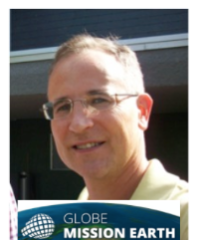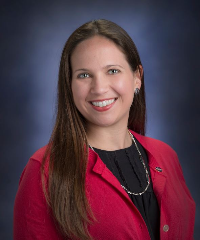GISN & STEM Professionals' Blog - GLOBE International STEM Network
GISN & STEM Professionals' Blog
The GISN and STEM Professional's Blog is an online collaborative effort where scientists associated with GLOBE post their thoughts, comments, and philosophies about a variety of science topics.
GLOBE strongly encourages positive and productive discussions to
further advance the scientific understanding of all involved with the
GLOBE Program.
Filter By:
Blogs List
We are kicking off the Urban Heat Island Effect campaign today with a heat wave in the eastern United States. Many record temperatures were broken today with highs reaching 32 to 35 C. 53 sites around the world entered data already today, October 1, 2019. You can see that most of the observations were in places of the world where it has been pretty warm. The coolest observation came from Alaska.
My students, Shefa and Ahmad, took surface temperature observations of a grassy field in front of my building at the University of Toledo and then of the parking lot behind the building. ...
Read More »
Posted in:
NASA está solicitando tu ayuda para determinar “¿Qué ves en tu cielo?” El equipo NASA GLOBE nube quiere estudiar diferencias en nubes y aerosoles. La data colectada durante este reto del otoño en el hemisferio norte o primavera en el hemisferio sur será comparada con los resultados obtenidos durante el reto de primavera del 2018.
Puedes ayudar sometiendo observaciones de nubes, polvo atmosférico, calina, o humo (límite 10 por día) a GLOBE usando cualquiera de las opciones de entrada de datos, incluyendo la aplicación móvil GLOBE Observer.
Los participantes ...
Posted in:
Curriculum:
STEM
ASSESSMENT AND EVALUATION
EDUCATION RESEARCH
LANGUAGE CULTURE AND ARTS
SCIENCE AND MATH
TECHNOLOGY
Event Topics:
CAMPAIGNS AND PROJECTS (IOPS, ETC)
OTHER
GLOBE LEARNING EXPEDITIONS
SCIENCE SYMPOSIA AND FAIRS
MEETINGS
WORKSHOPS
COMPETITIONS
GLOBE Science Topics:
EARTH SYSTEM SCIENCE
GENERAL SCIENCE
GENERAL SCIENCE @ES
CLIMATE CHANGE
DATA INCLUDED
BACKYARD SCIENCE
CLIMATE
MEETINGS/CONFERENCES
SCIENTIST SKILLS
EARTH AS A SYSTEM
GLOBE PROTOCOLS
GLOBE Working Groups:
EVALUATION WORKING GROUP
SCIENCE WORKING GROUP
EDUCATION WORKING GROUP
TECHNOLOGY WORKING GROUP
Investigation Areas:
ATMOSPHERE
EARTH AS A SYSTEM
News Topics:
VIRTUAL SCIENCE FAIR
IOPS
REGIONS
CALENDAR
SCRC RESEARCH
TRAINING
COMPETITIONS
MEETINGS
VIDEO
Primary Audience:
PARTNERS
SCIENTISTS
ALUMNI
COUNTRY COORDINATORS
TRAINERS
TEACHERS
STUDENTS
Student Research Reports:
U.S. STUDENT RESEARCH SYMPOSIA (SRS)
INTERNATIONAL VIRTUAL SCIENCE SYMPOSIUM REPORT
STANDARD RESEARCH REPORT
Teacher's Guide:
GRADE LEVELS
DOCUMENT TYPES
LANGUAGES
INVESTIGATION AREA DOCUMENTS
Tú puedes reportar el cielo como 100% cubierto u obscurecido usando el protocolo de nubes en GLOBE y en la aplicación GLOBE Observer. ¿Cuál es la diferencia? Este blog tiene consejos para ayudarte. Todas las fotografías en este blog fueron colectadas por observadores como tú. ¡Gracias!
Al principio encontré la diferencia entre cubierto y obscurecido algo confuso, pero cuando entendí el significado de ambas, pude mejorar mis observaciones. Empecemos con definir ambos términos:
Cubierto – Noventa por ciento o más del cielo está cubierto por nubes. En esta situación ...
Posted in:
Curriculum:
STEM
ASSESSMENT AND EVALUATION
EDUCATION RESEARCH
SCIENCE AND MATH
TECHNOLOGY
Event Topics:
CAMPAIGNS AND PROJECTS (IOPS, ETC)
OTHER
SCIENCE SYMPOSIA AND FAIRS
COMPETITIONS
GLOBE Science Topics:
EARTH SYSTEM SCIENCE
GENERAL SCIENCE
GENERAL SCIENCE @ES
CLIMATE CHANGE
DATA INCLUDED
BACKYARD SCIENCE
CLIMATE
EARTH AS A SYSTEM
SCIENTIST SKILLS
GLOBE PROTOCOLS
GLOBE Working Groups:
EDUCATION WORKING GROUP
TECHNOLOGY WORKING GROUP
SCIENCE WORKING GROUP
Investigation Areas:
ATMOSPHERE
EARTH AS A SYSTEM
Learning Activities:
EARTH AS A SYSTEM
ATMOSPHERE AND CLIMATE
News Topics:
VIRTUAL SCIENCE FAIR
REGIONS
TRAINING
COMPETITIONS
MEETINGS
Primary Audience:
PARTNERS
SCIENTISTS
ALUMNI
COUNTRY COORDINATORS
TRAINERS
TEACHERS
STUDENTS
Student Research Reports:
U.S. STUDENT RESEARCH SYMPOSIA (SRS)
INTERNATIONAL VIRTUAL SCIENCE SYMPOSIUM REPORT
Teacher's Guide:
STANDARDS REQUIREMENTS
GRADE LEVELS
DOCUMENT TYPES
LANGUAGES
INVESTIGATION AREA DOCUMENTS
Audience : Everyone! (Students and teachers all grade levels, informal educators, and the general public)
Dates : October 15, 2019 - November 15, 2019
Observations : Clouds and aerosols (dust storms, haze, smoke). Limit 10 per day.
NASA is requesting your help to determine “What’s up in your Sky”. The GLOBE Clouds team wants to study differences in clouds and aerosols. The data collected during this fall challenge will be compared to results from the 2018 Spring Clouds Challenge. Help by submitting clouds, dust, haze or smoke observations ( limit of 10 per day ) to ...
Posted in:
Curriculum:
STEM
EDUCATION RESEARCH
LANGUAGE CULTURE AND ARTS
SCIENCE AND MATH
TECHNOLOGY
Event Topics:
CAMPAIGNS AND PROJECTS (IOPS, ETC)
OTHER
COMPETITIONS
GLOBE Science Topics:
EARTH SYSTEM SCIENCE
GENERAL SCIENCE
GENERAL SCIENCE @ES
CLIMATE CHANGE
BACKYARD SCIENCE
CLIMATE
EARTH AS A SYSTEM
SCIENTIST SKILLS
GLOBE PROTOCOLS
GLOBE Working Groups:
EDUCATION WORKING GROUP
TECHNOLOGY WORKING GROUP
SCIENCE WORKING GROUP
Investigation Areas:
ATMOSPHERE
EARTH AS A SYSTEM
Learning Activities:
EARTH AS A SYSTEM
ATMOSPHERE AND CLIMATE
News Topics:
IOPS
REGIONS
CALENDAR
COMPETITIONS
Primary Audience:
PARTNERS
SCIENTISTS
ALUMNI
COUNTRY COORDINATORS
TRAINERS
TEACHERS
STUDENTS
Student Research Reports:
U.S. STUDENT RESEARCH SYMPOSIA (SRS)
INTERNATIONAL VIRTUAL SCIENCE SYMPOSIUM REPORT
STANDARD RESEARCH REPORT
Teacher's Guide:
GRADE LEVELS
INVESTIGATION AREA DOCUMENTS
Guest Scientist Blog by Kayla M. Thomas, McNair Scholar, Southern Nazarene University
Oklahoma has experienced three major outbreaks of West Nile Virus (WNV) since its local introduction in 2002. State and local health agencies provide surveillance of mosquito-borne diseases although reduced resources and personnel limits its scope. With the addition of citizen scientists from the greater Oklahoma City, I was able to analyze ongoing mosquito observations by using NASA’s GLOBE Observer mobile app during the 2019 mosquito season.
Citizen scientist participation studies have ...
Posted in:
Guest Scientist Blog by Kenan Arica, NASA JPL Summer Intern
Mosquitoes are vectors for diseases such as malaria, dengue, Zika, Rift Valley fever, West Nile virus, chikungunya and other diseases. Unfortunately, climate change is expected to make the spread of mosquito-borne diseases worse. This summer, I did some exploratory research to see if we could combine the power of GLOBE citizen science data and social media to learn about where mosquitoes are found.
This summer I worked with the GLOBE Observer Mosquito Habitat Mapper (MHM) data. To ensure we get the ...
Posted in:
Guest Scientist Blog by Jacqueline Castellanos, NASA JPL Summer Intern
My summer internship at NASA Jet Propulsion Laboratory exposed me to all parts of the scientific process. I went on a hike in search of mosquitoes, collected data, and I had the opportunity to teach teachers how to use the GLOBE Observer Mosquito Habitat Mapper. In my analysis, I learned how to work with data of varying quality and saw how environmental factors affect mosquito abundance. Most importantly, I learned that data given context and explored in meaningful ways can help us understand the problems we ...
Posted in:
In the GLOBE Clouds protocol and GLOBE Observer app, you can report if your sky is “overcast” or “obscured”. But what’s the difference? Below are some tips to help! All the photographs featured were collected by observers just like you - Thank you!
I found “obscured” and “overcast” very confusing at first, but when I understood what they meant, things made much more sense. Let’s start by defining them:
Overcast – The sky is completely covered by clouds (cloud cover greater than 90%). This means that you will see little or no blue sky. When it’s overcast, you are looking at ...
Posted in:
Curriculum:
EDUCATION RESEARCH
STEM
SCIENCE AND MATH
TECHNOLOGY
Event Topics:
CAMPAIGNS AND PROJECTS (IOPS, ETC)
GLOBE LEARNING EXPEDITIONS
OTHER
GLOBE Science Topics:
EARTH SYSTEM SCIENCE
GENERAL SCIENCE
GENERAL SCIENCE @ES
CLIMATE CHANGE
BACKYARD SCIENCE
CLIMATE
EARTH AS A SYSTEM
SCIENTIST SKILLS
GLOBE PROTOCOLS
GLOBE Working Groups:
EDUCATION WORKING GROUP
TECHNOLOGY WORKING GROUP
SCIENCE WORKING GROUP
Investigation Areas:
ATMOSPHERE
EARTH AS A SYSTEM
Learning Activities:
EARTH AS A SYSTEM
ATMOSPHERE AND CLIMATE
News Topics:
COMPETITIONS
Primary Audience:
PARTNERS
SCIENTISTS
ALUMNI
COUNTRY COORDINATORS
TRAINERS
STUDENTS
TEACHERS
NASA GLOBE Clouds team with summer intern (from left to right: Tina Rogerson, Kevin Ivey, Marilé Colón Robles.
The NASA GLOBE Clouds team has been delighted to have recent high school graduate Kevin Ivey this summer as our intern through NASA's Internships and Fellowships program [ link ]. Read about his experience this summer as he tackled big data!
I’m Kevin Ivey and I’ve been interning with NASA GLOBE Clouds at NASA Langley Research Center this summer. I graduated high school in June and I’ll be a first-year at the University of Virginia this ...
Posted in:
Curriculum:
STEM
ASSESSMENT AND EVALUATION
EDUCATION RESEARCH
LANGUAGE CULTURE AND ARTS
SCIENCE AND MATH
TECHNOLOGY
Event Topics:
CAMPAIGNS AND PROJECTS (IOPS, ETC)
GLOBE Science Topics:
SCIENTIST SKILLS
GENERAL SCIENCE
CLIMATE
GLOBE Working Groups:
SCIENCE WORKING GROUP
EDUCATION WORKING GROUP
Investigation Areas:
ATMOSPHERE
Learning Activities:
EARTH AS A SYSTEM
ATMOSPHERE AND CLIMATE
Primary Audience:
TRAINERS
TEACHERS
STUDENTS
PARTNERS
SCIENTISTS
ALUMNI
COUNTRY COORDINATORS
¿Vives en un área que tiene tormentas de polvo atmosférico? Nos gustaría que fotografíes el evento y envíes tus fotos usando el app GLOBE Observer. ¿Ya has estado enviando datos sobre tormentas de polvo atmosférico? ¡MUCHAS GRACIAS! Ahora queremos que todos sepan que pueden enviar datos sobre estas tormentas con GLOBE Observer usando los siguientes pasos.
Conoce a los científicos
Daniel Tong es un pronosticador de polvo atmosférico con el Programa Nacional de Capacidades de Pronóstico de Calidad del Aire de la NOAA y el Equipo de Ciencias ...
Posted in:
Curriculum:
STEM
EDUCATION RESEARCH
SCIENCE AND MATH
Event Topics:
CAMPAIGNS AND PROJECTS (IOPS, ETC)
GLOBE Science Topics:
EARTH SYSTEM SCIENCE
GENERAL SCIENCE
GENERAL SCIENCE @ES
DATA INCLUDED
CLIMATE
EARTH AS A SYSTEM
SCIENTIST SKILLS
GLOBE PROTOCOLS
GLOBE Working Groups:
EDUCATION WORKING GROUP
TECHNOLOGY WORKING GROUP
SCIENCE WORKING GROUP
Investigation Areas:
ATMOSPHERE
EARTH AS A SYSTEM
Learning Activities:
ATMOSPHERE AND CLIMATE
News Topics:
REGIONS
Primary Audience:
PARTNERS
SCIENTISTS
ALUMNI
COUNTRY COORDINATORS
TRAINERS
TEACHERS
STUDENTS
Teacher's Guide:
INVESTIGATION AREA DOCUMENTS
Left: SEES Mosquito Mapper intern Maia W. in the field, sampling a mosquito larvae habitat on a construction site in her hometown. Right: GLOBE Observer Land Cover observations collected alongside mosquito habitat identifications provide important data for analysis. Photo credit: Author.
As part of our field research, SEES interns identify local potential mosquito breeding habitats. As I live in an area that is cold and rainy most of the year, I did not anticipate finding any larvae, and when I did find some, it was not in the area I expected. ...
Posted in:
# 19 August 2019
Prepared by Helen Amos, helen.m.amos@nasa.gov
How to Download Dust Observations Reported through GLOBE
Dust event on 10 July 2019. Photo credit: GLOBE
Citizen scientists from around the world have been reporting dust events using the NASA GLOBE Observer app . You can learn about how to get involved here.
This blog offers step-by-step instructions on how to download GLOBE ...
Posted in:
Curriculum:
STEM
SCIENCE AND MATH
TECHNOLOGY
Event Topics:
CAMPAIGNS AND PROJECTS (IOPS, ETC)
GLOBE Science Topics:
EARTH SYSTEM SCIENCE
GENERAL SCIENCE
DATA INCLUDED
BACKYARD SCIENCE
CLIMATE
SCIENTIST SKILLS
GLOBE PROTOCOLS
GLOBE Working Groups:
EDUCATION WORKING GROUP
SCIENCE WORKING GROUP
Investigation Areas:
ATMOSPHERE
EARTH AS A SYSTEM
Learning Activities:
EARTH AS A SYSTEM
ATMOSPHERE AND CLIMATE
News Topics:
TRAINING
COMPETITIONS
Primary Audience:
PARTNERS
SCIENTISTS
ALUMNI
COUNTRY COORDINATORS
TRAINERS
TEACHERS
STUDENTS
Teacher's Guide:
INVESTIGATION AREA DOCUMENTS
SEES Mosquito Mapper intern Lindsay W. in the field, sampling a mosquito larvae habitat site in her study area. Photo credit: Author.
California has recently emerged from a multi-year drought, but I live at the edge of a town in the chaparral where water is typically scarce. I often travel miles by car to find potential mosquito habitats, only to find no larvae in those water sources.
I eventually contacted Vector Control in hopes that they could direct me to potential breeding sites, and they sent me a few locations. As of yet, most sites I’ve visited have had water and no ...
Posted in:
Left: example larva of the genus Toxorhynchites recovered from one of the author's research traps. Right: Larval specimen of prey, Culex quinquefasciatus, for comparison. Toxorhynchites are predator larvae and easily recognized by their unique morphology and larger size. Photo credit: Author.
Toxorhynchites is part of the mosquito family (Culicidae), also known as the “elephant mosquito” and “mosquito eater” and for good reason! These formidable larvae use their mandibles to prey on the larvae of other mosquitoes inhabiting the ...
Posted in:
SEES Mosquito Mapper intern Parker L. in his lab, identifying a specimen recovered from one of his mosquito research traps. Photo credit: Author.
I am fascinated at how effectively Aedes albopictus has expanded beyond its historical geographical origins in Asia, sticking its proboscis into Texas along with every continent across the globe except Antarctica. This invasive mosquito, which serves as a vector for dengue and chikungunya, has been enormously successful in utilizing alternative breeding containers to supplement its natural oviposition sites. In fact, it ...
Posted in:
SEES Mosquito Mapper intern Thien-Nha T. in the field, documenting potential larvae habitat sites. Photo credit: Author.
Before this project, I never ever imagined I would be interested in studying any type of bugs, much less mosquitoes -- my itch-causing nemesis. However, the more I realized how interconnected these bugs are with the rest of the world and even my own life, the more I saw their importance.
My field experiment was designed to figure out what vegetation and color surrounding would attract the most mosquitoes. The structure and goal of the experiment were ...
Posted in:
SEES Mosquito Mapper intern in the field, setting mosquito traps. Photo credit: Clara U.
Something that has fascinated me in the research I have done so far is the vast impact that human activity has on the distribution of mosquito communities. Globalization and human travel are thought to be responsible for introducing many mosquito-borne diseases to unlikely areas, for example, spreading the Culex tarsalis , a vector of western equine encephalitis, to Washington State. Artificial habitats that foster mosquito breeding can develop in abandoned tires, plastic containers, and ...
Posted in:
Do you live in an area that has dust storms? The Global Learning and Observations to Benefit the Environment Program (GLOBE) team would like you to photograph dust events in your area and submit your photos using the GLOBE Observer app .
Join NASA GLOBE Clouds Project Scientist, Marilé Colón Robles, to learn more about how to collect your observations and educational resources you can use with formal and informal audiences. Your observations will be used by scientists to verify satellite observations and see if their models have successfully predicted these ...
Posted in:
Curriculum:
EDUCATION RESEARCH
SCIENCE AND MATH
TECHNOLOGY
Event Topics:
CAMPAIGNS AND PROJECTS (IOPS, ETC)
GLOBE Science Topics:
GENERAL SCIENCE
CLIMATE CHANGE
DATA INCLUDED
BACKYARD SCIENCE
CLIMATE
EARTH AS A SYSTEM
SCIENTIST SKILLS
GLOBE PROTOCOLS
GLOBE Working Groups:
EDUCATION WORKING GROUP
SCIENCE WORKING GROUP
Investigation Areas:
ATMOSPHERE
PEDOSPHERE (SOIL)
Learning Activities:
ATMOSPHERE AND CLIMATE
SOIL
News Topics:
CALENDAR
TRAINING
Primary Audience:
PARTNERS
SCIENTISTS
ALUMNI
COUNTRY COORDINATORS
TRAINERS
TEACHERS
STUDENTS
Teacher's Guide:
GRADE LEVELS
INVESTIGATION AREA DOCUMENTS
Dr. Caio França speaking at the Science Museum Oklahoma.
Oklahoma is an ecologically diverse state in the Southern Plains region of the U.S. It is part of the central flyway for migratory birds, which makes it a sentinel location for West Nile Virus (WNV) surveillance. Why birds? Birds play a role in the WNV transmission cycle. Mosquitoes become infected with WNV when they bite an infected bird. Birds can develop high levels of the virus in their bloodstream. Because WNV is usually non-lethal in birds, birds serve as reservoir hosts. In disease ecology, there are organisms that ...
Posted in:
Do you live in an area that has dust storms? We would like for you to photograph the dust event and submit your photos using the GLOBE Observer app. Have you already been reporting dust storms? We noticed and what to say THANK YOU! Now we want to get the word out that anyone can report dust storms with the app following the steps below.
Watch the recorded webinar on how to submit your observations using the NASA GLOBE Observer app and learn about educational resources you can use in your classroom or in an informal setting ...
Posted in:
Event Topics:
OTHER
GLOBE Science Topics:
EARTH AS A SYSTEM
SCIENTIST SKILLS
GLOBE PROTOCOLS
GENERAL SCIENCE
GENERAL SCIENCE @ES
CLIMATE
GLOBE Working Groups:
TECHNOLOGY WORKING GROUP
SCIENCE WORKING GROUP
EDUCATION WORKING GROUP
News Topics:
REGIONS
CALENDAR
Primary Audience:
TRAINERS
TEACHERS
STUDENTS
PARTNERS
SCIENTISTS
ALUMNI
COUNTRY COORDINATORS
—
20 Items per Page








